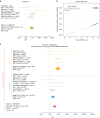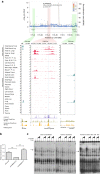Re-analysis of public genetic data reveals a rare X-chromosomal variant associated with type 2 diabetes
- PMID: 29358691
- PMCID: PMC5778074
- DOI: 10.1038/s41467-017-02380-9
Re-analysis of public genetic data reveals a rare X-chromosomal variant associated with type 2 diabetes
Erratum in
-
Publisher Correction: Re-analysis of public genetic data reveals a rare X-chromosomal variant associated with type 2 diabetes.Nat Commun. 2018 May 30;9(1):2162. doi: 10.1038/s41467-018-04170-3. Nat Commun. 2018. PMID: 29849136 Free PMC article.
Abstract
The reanalysis of existing GWAS data represents a powerful and cost-effective opportunity to gain insights into the genetics of complex diseases. By reanalyzing publicly available type 2 diabetes (T2D) genome-wide association studies (GWAS) data for 70,127 subjects, we identify seven novel associated regions, five driven by common variants (LYPLAL1, NEUROG3, CAMKK2, ABO, and GIP genes), one by a low-frequency (EHMT2), and one driven by a rare variant in chromosome Xq23, rs146662057, associated with a twofold increased risk for T2D in males. rs146662057 is located within an active enhancer associated with the expression of Angiotensin II Receptor type 2 gene (AGTR2), a modulator of insulin sensitivity, and exhibits allelic specific activity in muscle cells. Beyond providing insights into the genetics and pathophysiology of T2D, these results also underscore the value of reanalyzing publicly available data using novel genetic resources and analytical approaches.
Conflict of interest statement
The authors declare no competing financial interests.
Figures





